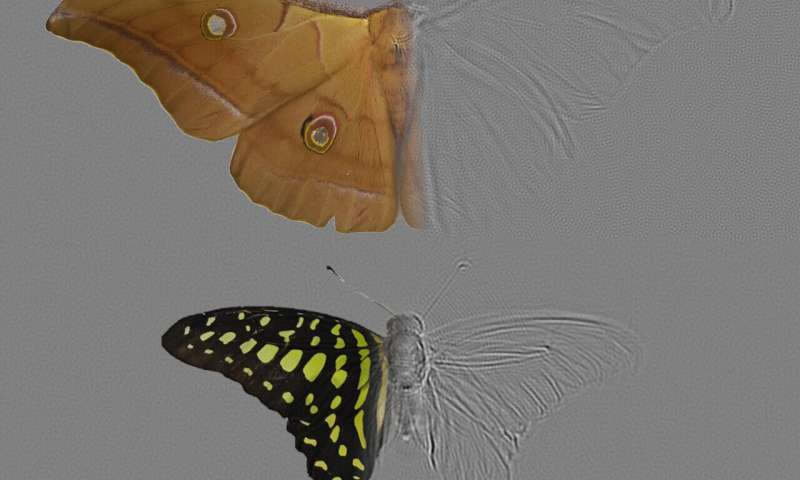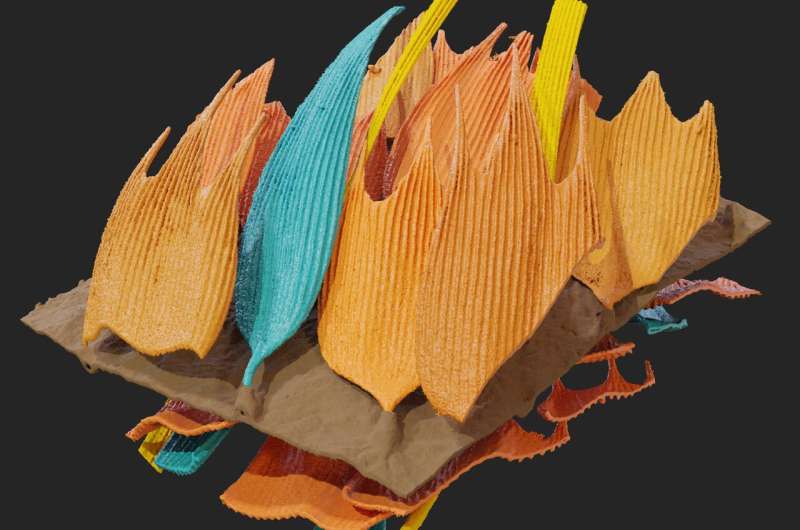Moths pull ahead in evolutionary arms race with sophisticated wing design

Ultra-thin, super-absorbent and extraordinarily designed to detract attention, the wings of moths could hold the key for developing technological solutions to survive in a noisy world.
As revealed in a new study published today in PNAS, researchers from the University of Bristol have discovered the precise construction of moths wings that have enabled the species to evade its most troublesome predator in a 65 million-year-old evolutionary arms race.
Using an array of analytical techniques, including airborne cross-sectional imaging, acoustic-mechanics and refractometry, the team from Bristol's School of Biological Sciences found that the very thin scale layer on moth wings has evolved extraordinary ultrasound-absorptive properties that provide stealth acoustic camouflage against echolocating bats.
What makes the team's discovery even more remarkable is that they have identified the first known naturally occurring acoustic metamaterial. A metamaterial traditionally describes an artificial composite material engineered to display physical properties that surpass those available in nature. Naturally occurring metamaterials are extremely rare and had previously never been described in the world of acoustics.

Earlier this year, behavioural acoustics and sensory ecology expert Dr. Marc Holderied and his co-researchers reported how deaf moths had evolved ultrasound absorbing scales on their bodies that allowed them to absorb 85 per cent of the incoming sound energy that bats use to detect them.
The need to survive meant that moths evolved a 1.5mm deep scale protective barrier that acts as a porous sound absorber. Such a protective barrier would not work on the wings though, where the increased thickness would hinder the moths' ability to fly. A key feature of acoustic metamaterials is that they are much smaller than the wavelength of sound that they are acting on, allowing them to be much thinner than traditionally constructed sound absorbers.
In this latest study, the Bristol team, led by co first authors Dr. Thomas Neil and Dr. Zhiyuan Shen, reveal that moths have gone one life-saving step further, creating a resonant absorber that is 100 times thinner than the wavelength of the sound it absorbs, thus enabling the insects to maintain their lightness while reducing the potential for bats to detect the echoes of their wings in flight.
By examining the sophisticated cross-sectional images of sound captured using ultrasound tomography, the team discovered that moth wings have evolved to make a resonant absorber that is effective protection against echolocating bats. The findings could significantly bolster the efforts of material scientists, acousticians and sonar engineers to design bio-inspired sound absorbers with exceptional deep-subwavelength performance.

"Most amazingly, moth wings also evolved a way to make a resonant absorber absorb all bat frequencies, by adding another amazing feature—they assemble many of these resonators individually tuned to different frequencies into an array of absorbers, which together create broadband absorption by acting as an acoustic metamaterial—the first known in nature," said head researcher Dr. Holderied. "Such a broadband absorption is very hard to achieve in the ultrathin structures of moths' wings, which is what makes it so remarkable."
This goes well beyond the limits attainable with classical porous absorbers of the kind currently used to absorb sound in office environments which use large, thick materials.
Dr. Holderied added: "The promise is one of much thinner sound absorbers for our homes and offices, we would be getting close to a much more versatile and acceptable sound absorber 'wallpaper' rather than bulky absorber panels."
This latest study builds on the team's earlier work on acousto-mechanics of individual scales, and shows how the more traditional sound absorption by scales on moth bodies can be achieved with much thinner structures on wings to provide whole organism acoustic protection.
More information: Thomas R. Neil el al., "Moth wings are acoustic metamaterials," PNAS (2020). www.pnas.org/cgi/doi/10.1073/pnas.2014531117
Journal information: Proceedings of the National Academy of Sciences
Provided by University of Bristol



















